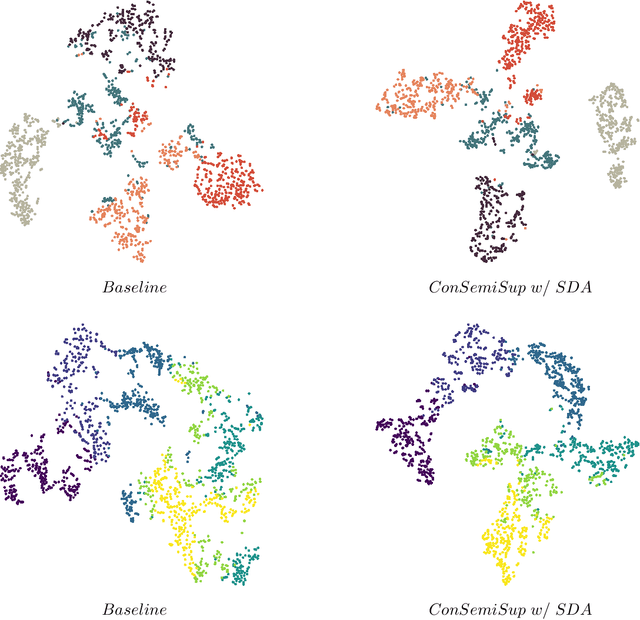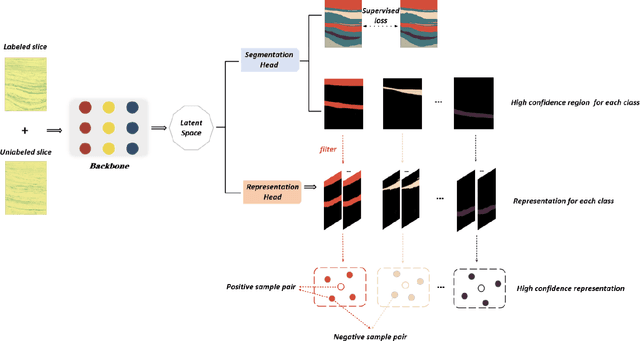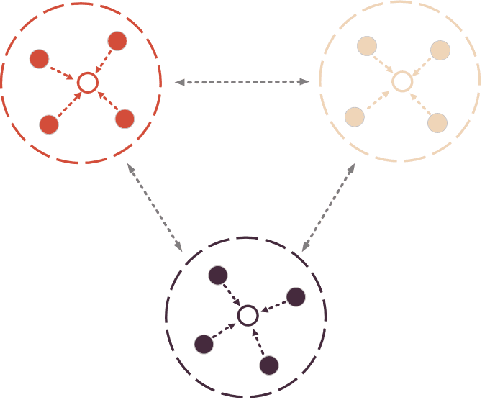Hongjie Duan
ContrasInver: Voxel-wise Contrastive Semi-supervised Learning for Seismic Inversion
Feb 14, 2023Abstract:Recent studies have shown that learning theories have been very successful in hydrocarbon exploration. Inversion of seismic into various attributes through the relationship of 1D well-logs and 3D seismic is an essential step in reservoir description, among which, acoustic impedance is one of the most critical attributes, and although current deep learningbased impedance inversion obtains promising results, it relies on a large number of logs (1D labels, typically more than 30 well-logs are required per inversion), which is unacceptable in many practical explorations. In this work, we define acoustic impedance inversion as a regression task for learning sparse 1D labels from 3D volume data and propose a voxel-wise semisupervised contrastive learning framework, ContrasInver, for regression tasks under sparse labels. ConstraInver consists of several key components, including a novel pre-training method for 3D seismic data inversion, a contrastive semi-supervised strategy for diffusing well-log information to the global, and a continuous-value vectorized characterization method for a contrastive learning-based regression task, and also designed the distance TopK sampling method for improving the training efficiency. We performed a complete ablation study on SEAM Phase I synthetic data to verify the effectiveness of each component and compared our approach with the current mainstream methods on this data, and our approach demonstrated very significant advantages. In this data we achieved an SSIM of 0.92 and an MSE of 0.079 with only four well-logs. ConstraInver is the first purely data-driven approach to invert two classic field data, F3 Netherlands (only four well-logs) and Delft (only three well-logs) and achieves very reasonable and reliable results.
Contrastive Learning Approach for Semi-Supervised Seismic Facies Identification Using High-Confidence Representations
Oct 12, 2022



Abstract:The manual seismic facies annotation relies heavily on the experience of seismic interpreters, and the distribution of seismic facies in adjacent locations is very similar, which means that much of the labeling is costly repetitive work. However, we found that training the model with only a few evenly sampled labeled slices still suffers from severe classification confusion, that is, misidentifying one class of seismic facies as another. To address this issue, we propose a semi-supervised seismic facies identification method using features from unlabeled data for contrastive learning. We sample features in regions with high identification confidence, and use an pixel-level instance discrimination task to narrow the intra-class distance and increase the inter-class distance. Instance discrimination encourages the latent space to produce more distinguishable decision boundaries and reduces the bias in the features of the same class. Our method only needs to extend one branch to compute the contrastive loss without extensive changes to the network structure. We have conducted experiments on two public seismic surveys, SEAM AI and Netherlands F3, and the proposed model achieves an IOU score of more than 90 using only 1% of the annotations in the F3 survey.
MDA GAN: Adversarial-Learning-based 3-D Seismic Data Interpolation and Reconstruction for Complex Missing
Apr 08, 2022



Abstract:The interpolation and reconstruction of missing traces is a crucial step in seismic data processing, moreover it is also a highly ill-posed problem, especially for complex cases such as high-ratio random discrete missing, continuous missing and missing in fault-rich or salt body surveys. These complex cases are rarely mentioned in current sparse or low-rank priorbased and deep learning-based approaches. To cope with complex missing cases, we propose Multi-Dimensional Adversarial GAN (MDA GAN), a novel 3-D GAN framework. It employs three discriminators to ensure the consistency of the reconstructed data with the original data distribution in each dimension. The feature splicing module (FSM) is designed and embedded into the generator of this framework, which automatically splices the features of the unmissing part with those of the reconstructed part (missing part), thus fully preserving the information of the unmissing part. To prevent pixel distortion in the seismic data caused by the adversarial learning process, we propose a new reconstruction loss Tanh Cross Entropy (TCE) loss to provide smoother gradients. We experimentally verified the effectiveness of the individual components of the study and then tested the method on multiple publicly available data. The method achieves reasonable reconstructions for up to 95% of random discrete missing, 100 traces of continuous missing and more complex hybrid missing. In surveys of fault-rich and salt bodies, the method can achieve promising reconstructions with up to 75% missing in each of the three directions (98.2% in total).
 Add to Chrome
Add to Chrome Add to Firefox
Add to Firefox Add to Edge
Add to Edge